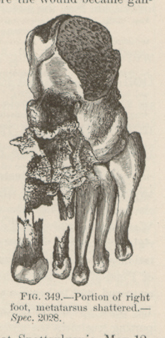Title: Elderkin, W. A.
Source text: The Medical and Surgical History of the War of the Rebellion. (1861-65.), Part 3, Volume 2 (Washington, DC: Government Printing Office, 1883), 603.
Civil War Washington ID: med.d2e23471
TEI/XML: med.d2e23471.xml
CASE 881.—Private W. A. Elderkin, Co. C, 6th Maine, aged 24 years, was wounded at Rappahannock Station, November 7, 1863, by a minié ball, which entered the dorsum of the right foot, fracturing the metatarsal bones, and making its exit at the plantar surface. Two days afterwards he was admitted to Harewood Hospital at Washington, where the wound became gangrenous about November 23d. For this a local treatment of nitric acid and oakum dressing was applied and a constitutional treatment of tonics, stimulants, and beef tea diet was administered. The disease, however, not being arrested and the patient growing weaker, operative interference became necessary, and Pirogoff's amputation was performed on December 6th by Surgeon R. B. Bontecou, U. S. V. After the operation the parts were kept properly adjusted and the supporting treatment was continued. About January 4, 1864, the progress of the case was interrupted by erysipelas making its appearance, followed by sloughing of the soft parts to some extent. Tincture of chloride of iron was then prescribed and wheat flour was applied locally. The inflammation was arrested in about two weeks, after which the patient's health improved daily and the wound healed rapidly. He was discharged from service with a useful stump April 23, 1864, and pensioned. The amputated part of the foot (Spec. 2028), contributed with the history by the operator, is represented in the annexed cut (FIG. 349), and shows the metatarsus to have been badly shattered, some of the fragments being necrosed and a slight effusion of callus having occurred in the neighboring parts. After receiving his discharge the patient was supplied with a "Palmer" artificial foot, which, however, did not prove satisfactory, and is reported to have become entirely useless in about two months. The pensioner died December 14, 1866, his physician, Dr. A. G. Peabody, of Machias, Maine, certifying that "death was caused by consumption arising from hardship, exposure, and the loss of the foot, the amputated foot leaving a stump which never thoroughly healed, but remained a constant drain upon the vital powers of the man's constitution."
